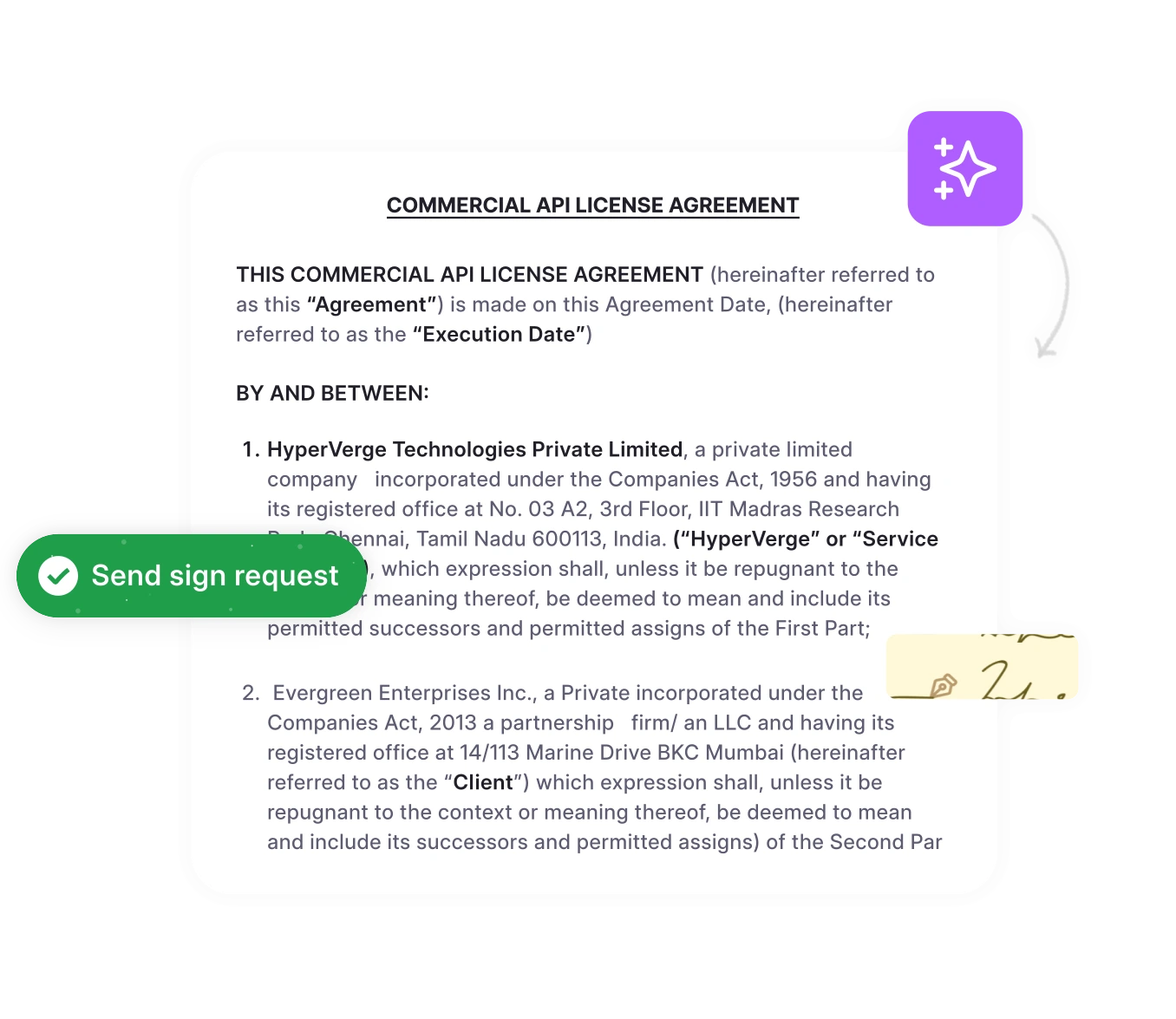When your business hosts events, hires contractors, or allows property access, you face liability exposure that could result in costly legal claims. A hold harmless agreement transfers this risk from one party to another, protecting businesses and individuals from financial liability for injuries, damages, or losses arising from specific activities. According to the 2024 Lex Machina Contracts: Commercial Litigation Report, breach of contract disputes increased 15% in 2023, with claimants succeeding three times more often than defendants when agreements lacked clear, enforceable language.
This guide covers what hold harmless agreements are, when to use them, how to create enforceable versions, and modern management approaches. Whether evaluating risk management strategies or reviewing indemnity agreements, understanding hold harmless provisions helps you make informed decisions about contractual liability protection.
What is a hold harmless agreement?
A hold harmless agreement is a legal contract where one party agrees to protect another from liability claims, lawsuits, or financial responsibility arising from specific activities or situations. These agreements, also called indemnity agreements or hold-harmless clauses when embedded in larger contracts, establish who assumes the risk of injuries, property damage, or other losses.
For example, an event venue might require organizers to sign a hold-harmless form before hosting a conference, or a contractor might require clients to sign a hold-harmless letter before starting renovations. The hold harmless meaning centers on shifting liability from one party to another who agrees to assume that risk. Understanding what a hold harmless agreement is helps businesses determine whether signing such enforceable contracts aligns with their risk tolerance.
Ready to streamline your agreement workflows?
Modern contract lifecycle management platforms automate the creation, tracking, and renewal of hold harmless agreements across all your business relationships.
Book a DemoWhat are the 3 types of hold harmless agreements?
Not all hold harmless agreements offer equal protection or distribute risk the same way. Understanding the three primary types helps you determine which structure best suits your business relationship.
| Type | Who’s Protected | Risk Level | Common Use Cases |
| Unilateral (Broad Form) | One party fully protected | Highest risk for signer | Events, recreational activities |
| Intermediate (Modified) | Shared based on fault | Balanced protection | Construction, vendor contracts |
| Mutual (Reciprocal) | Both parties equally | Lowest individual risk | Partnerships, joint ventures |
Each type establishes different liability boundaries depending on your business needs.
1. Unilateral hold harmless agreement (broad form)
A unilateral hold harmless agreement provides complete protection to one party while the other assumes all liability, regardless of who caused the injury. The signing party agrees to hold the other harmless, even if that party’s negligence contributed.
A skydiving company might require customers to sign a broad-form hold-harmless waiver, accepting all responsibility for injuries. These carry the highest risk for signers. Many states, including California, Texas, and Florida, restrict broad form provisions in construction.
2. Intermediate hold harmless agreement (modified form)
An intermediate hold harmless agreement distributes liability based on each party’s degree of fault. The signing party holds the other party harmless only for losses caused by the signing party, not for the protected party’s negligence.
Construction projects frequently use intermediate hold-harmless language in which subcontractors indemnify contractors for damages the subcontractor causes. This balanced approach makes it more enforceable across jurisdictions and addresses the question ‘What does hold harmless mean?’ by creating proportional responsibility.
3. Mutual hold harmless agreement (reciprocal)
A mutual hold harmless agreement provides equal protection to both parties. Each agrees to hold the other harmless from claims arising from their own actions.
Businesses commonly use mutual agreements in vendor contract management relationships. Two companies collaborating might enter into a mutual provision under which each assumes responsibility for its own team’s actions. This works well when parties have equal bargaining power.
Which are the 6 essential components every hold harmless agreement must include?
A hold harmless clause is an example of risk allocation in contracts, establishing who bears responsibility for potential losses. A legally enforceable hold-harmless agreement requires specific elements to be valid and to protect the intended party. Missing any of these essential components can render the contract unenforceable or create ambiguity that leads to disputes.
| Component | What It Covers | Why It Matters |
| Identification of Parties | Full legal names and addresses | Establishes who has rights/obligations |
| Activity Description | Specific services, events, or situations | Defines scope of protection |
| Assumption of Risk | Acknowledgment of potential dangers | Proves informed consent |
| Liability Waiver Language | Clear release from claims | Core protection mechanism |
| Indemnification Clause | Who pays if claims arise | Financial responsibility allocation |
| Governing Law | Which state’s laws apply | Determines enforceability rules |
Each of these elements of a contract serves a specific legal purpose for validity.
1. Identification of parties
The hold harmless document must clearly identify all parties using full legal names and addresses. For companies, include the complete legal entity name (LLC, Inc., Corporation).
2. Description of activity
A valid hold harmless form must describe the specific activity or situation covered with enough detail to establish clear boundaries. Specific descriptions like “HVAC installation at 123 Main Street” establish precise coverage better than vague language.
3. Assumption of risk
The agreement should explicitly state that the signing party understands and acknowledges the risks. For a hold harmless agreement pdf to be enforceable, courts require evidence the signing party knew what risks they were accepting.
4. Liability waiver language
This represents the core of what is a hold harmless clause with clear language stating one party will not hold the other liable. Strong waiver language includes “releases from all liability” and “waives all claims” for maximum protection.
5. Indemnification clause
Beyond releasing liability, a comprehensive indemnification and hold harmless agreement requires one party to defend and indemnify the other from third-party claims, including legal fees and judgments.
6. Governing law provision
The agreement must specify which state’s contract law governs interpretation. This matters because states have different rules, with some prohibiting certain types entirely. Hold harmless agreements, California must comply with Civil Code Section 2782.
When do you need a hold harmless agreement? 5 common scenarios
Businesses use hold-harmless agreements across numerous industries when one party needs protection from potential liability.
1. Construction projects
Construction contract management often involves hold-harmless provisions among contractors, subcontractors, and property owners. Contractors might require subcontractors to sign a hold-harmless agreement to protect them from liability for the subcontractor’s work quality, safety violations, or employee injuries.
2. Event hosting
Event organizers and venues commonly require participants and vendors to sign hold harmless agreements before events. A music festival might use a simple hold-harmless agreement requiring food vendors to assume liability for foodborne illnesses, or conference centers might have clients sign a hold-harmless letter accepting responsibility for guest injuries.
3. Recreational activities
Businesses offering high-risk activities like rock climbing gyms, trampoline parks, or zip line tours typically require participants to sign waivers including hold harmless provisions. These agreements acknowledge the activity’s dangerous nature and prevent participants from holding the business liable for injuries from inherent risks.
4. Vendor relationships
Commercial contracts with vendors and contractors often include hold harmless clauses protecting businesses from liability arising from the vendor’s actions. A company hiring an event photographer might include a hold harmless and indemnity agreement requiring the photographer to assume responsibility for equipment damage or injuries.
5. Real estate transactions
Real estate hold-harmless agreements include protecting sellers from post-closing claims and buyers during property inspections. Sellers might require buyers to sign hold-harmless provisions before allowing property access for inspections, or landlords might include hold-harmless language in commercial leases.
Managing hundreds of agreements manually?
HyperStart’s AI-powered CLM platform centralizes all your hold harmless agreements with automated alerts, version control, and compliance tracking.
Book a DemoHow to create a hold harmless agreement in 5 steps
While attorney review is recommended, understanding the creation process helps you draft more effective initial versions.
Step 1: Identify the relationship and risk
Define the business relationship and specific risks you want to address. What activity creates liability? What injuries might occur? Who should bear responsibility? Document these before drafting clear contract language to ensure your agreement addresses actual risks.
Step 2: Choose the appropriate agreement type
Based on your risk analysis and state law requirements, determine whether you need a unilateral, intermediate, or mutual hold harmless agreement. Consider your bargaining power, industry standards, and state restrictions. Wrong structure choices can result in unenforceable contracts.
Step 3: Draft clear, specific language
Use precise, unambiguous language for all elements. Replace vague terms like “any injuries” with specific language like “bodily injuries, property damage, and financial losses.” Many sample hold-harmless agreement templates use overly broad language that courts might reject; customize to your situation.
Step 4: Include all essential components
Incorporate all six essential components: party identification, activity description, assumption of risk, liability waiver, indemnification clause, and governing law provision. Following how to write a contract ensures your agreement covers the necessary legal elements.
Step 5: Review with legal counsel and obtain signatures
Consult with an attorney licensed in your jurisdiction who can evaluate whether your draft complies with state law and provides the needed protection. After incorporating attorney feedback, obtain proper signatures from all parties, preferably with each party initialing each page.
Do hold-harmless agreements hold up in court? Understanding enforceability
A common question is “How binding is a hold harmless agreement?” The answer depends on several factors that determine whether courts will enforce these provisions in the event of a dispute.
Hold harmless agreements are generally enforceable if properly drafted and executed, but significant limitations exist. Courts scrutinize these agreements because they allow one party to avoid responsibility for its own actions.
Factors affecting enforceability
Several key elements determine whether a hold harmless provision will stand up in court:
- State law variations: Some jurisdictions prohibit certain types entirely or impose strict requirements on enforceability
- Language clarity: Courts interpret ambiguous terms against the party who drafted the agreement, making precise wording critical
- Public policy limits: Provisions violating fundamental fairness cannot be enforced, particularly for intentional harm or gross negligence
- Informed consent: Courts examine whether the signing party truly understood the risks and consequences before signing
- Proper execution: Valid signatures, witness requirements, and appropriate timing all impact whether courts will uphold the agreement
Understanding contract compliance requirements and avoiding contract ambiguity through precise language strengthens protection.
State-specific enforceability rules
Different states take dramatically different approaches to the enforceability of hold-harmless agreements, particularly in construction contexts.
| State | Key Restrictions | Enforceability Approach |
| California | Prohibits broad form in construction; limits indemnity for sole negligence | Moderate restrictions |
| Texas | Voids provisions for sole negligence in construction; requires express negligence language | Significant restrictions |
| Florida | Prohibits indemnity for own negligence in construction contracts | Strong restrictions |
| New York | Generally enforces unless grossly unfair or against public policy | More permissive |
A hold harmless agreement, Florida must comply with Florida Statute 725.06, which voids construction contract provisions requiring one party to indemnify another for that other party’s own negligence. A hold harmless agreement Texas must meet Texas Civil Practice and Remedies Code requirements, voiding construction indemnity for sole negligence unless expressly stated. California takes an intermediate approach where broad form construction agreements are void under Civil Code Section 2782.
What hold harmless agreements cannot protect against
Even in states that generally enforce these agreements, certain limitation of liability provisions remain unenforceable as a matter of public policy:
- Intentional acts: No protection for deliberately harmful actions or willful misconduct
- Gross negligence: Courts refuse to shield parties from reckless or extremely careless behavior
- Statutory violations: Cannot waive liability for failing to comply with legal requirements
- Fraud or misrepresentation: Agreements cannot protect parties who intentionally deceive others
- Future unknown injuries (in some contexts): Many states prohibit blanket waivers for unspecified future harm, particularly in medical malpractice
Courts refuse to enforce provisions that would eliminate all incentives for parties to maintain reasonable safety standards or act responsibly.
Hold harmless vs. indemnification vs. release of liability: Key differences
Many people use these terms interchangeably, but essential distinctions exist. Understanding these differences helps you choose the right legal tool.
| Agreement Type | Primary Focus | Timing | Financial Obligation | Use Case |
| Hold Harmless | Prevents claims/lawsuits | Future (prospective) | No payment required | Before activity starts |
| Indemnification | Covers losses and defense costs | Future (prospective) | Reimburses all costs | Third-party claim protection |
| Release of Liability | Gives up existing claims | Past (retrospective) | Often includes settlement | After incident occurs |
Hold harmless agreements
These agreements focus on preventing one party from holding another liable for injuries or damages. The emphasis lies on not pursuing claims against the protected party. These often appear in contract conditions as protective clauses. The hold harmless agreement meaning centers on relationship protection rather than financial compensation.
Indemnification agreements
These agreements go further by requiring one party to compensate or reimburse another for losses, damages, legal fees, and costs. If a third party sues the protected party, the indemnifying party must defend that lawsuit and pay judgments. A hold harmless and indemnity agreement pdf combines both protections. Indemnification imposes stronger financial obligations than simple hold-harmless provisions.
Releases of liability
These agreements typically occur after an incident has already happened, rather than prospectively before an activity. When someone signs a general release of liability, they give up their right to pursue existing claims, often in exchange for settlement payment. A release and hold harmless agreement might combine both concepts.
When to use each
Choose hold harmless agreements for prospective protection before activities begin. Select indemnification agreements when you want financial coverage for third-party claims. Use releases when settling past disputes. Many contracts include all three concepts together for comprehensive protection.
Manage hold harmless agreements with HyperStart
Hold harmless agreements serve as essential risk management tools, but their effectiveness depends on proper drafting, valid execution, and systematic tracking.
The challenge many businesses face is managing dozens or hundreds of hold-harmless agreements across multiple vendors, contractors, events, and relationships. Tracking expiration dates, renewal requirements, and compliance obligations becomes overwhelming when agreements are handled manually.
HyperStart – contract management software transforms agreement management by centralizing tracking of all your liability clauses in a single, AI-powered platform. Create customized templates that automatically populate with correct party information and applicable state law provisions. Set up automated alerts for renewal dates and expiration warnings so no critical agreement lapses. Contract management automation eliminates manual work, tracking multiple agreement versions, monitoring changing state laws, and coordinating signature collection.
Whether you manage a dozen hold harmless agreements or thousands across multiple business units, HyperStart provides the structure, automation, and visibility needed to protect your organization.












